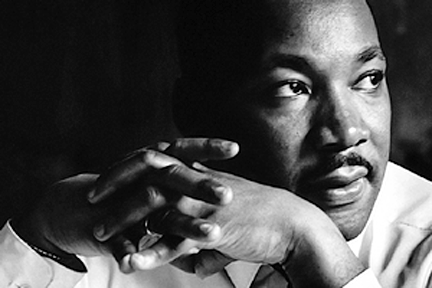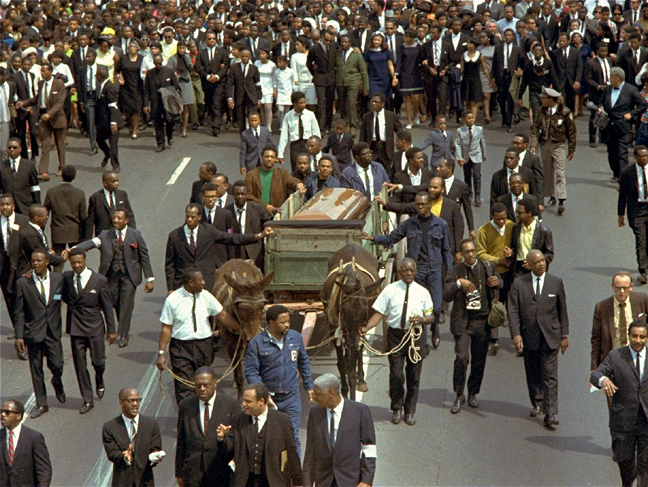
Minister, civil rights activist, and public opinion leader who changed the face of America
January 15, 1929, Atlanta, Georgia
Died
April 4, 1968, Memphis, Tennessee
Spouse
Coretta Scott King
Accomplishments
Leader of African American Civil Rights Leader
Nobel Peace Prize (1964)
Presidential Medal of Freedom (1977)
Congressional Gold Medal (2004)
Famous letters and speeches
“I have a dream” Speech
Letter from Birmingham jail
Letter to Coretta
Our God is Marching On (How Long? Not Long)
Martin Luther King Jr. became the predominant leader in the civil rights movement to end racial segregation and discrimination in America during the 1950s and 1960s, and was a leading spokesperson for nonviolent methods of achieving social change. His eloquence as a speaker and his personal charism—combined with a deeply rooted determination to establish equality among all races despite personal risk—won him a worldwide following. He was awarded the Nobel Peace Prize in 1964 and was selected by Time magazine as its Man of the Year. His “I Have a Dream “speech, which is now considered to be among the great speeches of American history, is frequently quoted. His success in galvanizing the drive for civil rights, however, made him the target of conservative segregationists who believed firmly in the superiority of the white race and feared social change. He was arrested over 20 times and had his home was bombed. Ultimately, he was assassinated on April 4, 1968, on the balcony of a motel where he was staying in Memphis. A monument to Dr. King was unveiled in the national capital in 2012.
Early Life of Martin Luther King Jr.
Martin Luther King Jr. was born Michael Luther King Jr., in Atlanta, Georgia, on January 15, 1929. His father, in a 1957 interview, said that both he and his son were supposed to be named for the leader of the Protestant Reformation but misunderstandings led to Michael being the name on birth records. The boy became the third member of his family to serve as pastor of the Ebenezer Baptist Church in Atlanta, following in the footsteps of his grandfather and father. His training and experience as a minister undoubtedly contributed to his renowned oratorical style and cadence.
He also followed the educational path taken by his father and grandfather: he got his education in Georgia’s segregated public schools (from which he graduated at age 15). And he received a B.A. degree from Atlanta’s Morehouse College, a traditionally black college. He then went on to study theology at Crozer Theological Seminary in Pennsylvania, an integrated school where he was elected president of his senior class although it was comprised primarily of white students. In 1955, he received an advanced degree from Boston College in Massachusetts; he had completed the residence for his doctorate two years earlier. (In 1991, a Boston University investigatory committee determined he had plagiarized portions of his doctoral dissertation; plagiarism was also discovered in his word at Crozer. However, the committee did not recommend his degree be revoked. Evidence of plagiarism had been discovered by Boston University archivists in the 1980s.)
While in Boston, he met and married Coretta Scott, who would be his lifetime partner in both marriage and his campaign for civil rights. In 1954, the couple moved to Montgomery, Alabama, where King had been hired as the pastor of the Dexter Avenue Baptist Church.
He was already active in the National Association for the Advancement of Colored People, America’s leading African-American organization. At the time of his move to Montgomery, he was a member of its executive committee, and in December 1955, he led a 382-day boycott of Montgomery’s segregated public bus system. Negroes, the term then used for those of African descent, were relegated to the back of the bus and forced to give up their seats if a white person wanted to sit. Since many blacks lived in poverty or near-poverty, few could afford automobiles, and public busses were essential to them for traveling to and from work and elsewhere. During the boycott, King became a target for segregationists. Personal abuse, arrest, and the bombing of his home made clear the risks he would be taking if he continued to work with the movement for civil rights.
In 1957, that movement spawned a new organization, the Southern Christian Leadership Conference, to focus on achieving civil rights. King was elected president. By dropping reference to Negroes or colored people in its title and instead using the term “Christian Leadership” the organization was declaring its goals were not just those of one race but should be those of all Christian people. King strongly influenced the ideals of the organization.
During the next 11 years, he would speak over 2,500 times at public events, traveling over six million miles. He also wrote articles and five books to spread the message farther. In 1963, he was a leader in the massive civil rights protests at Birmingham, Alabama, that drew the attention of all America—indeed, of the entire world—to the discrimination African Americans faced and their demands for change. Arrested during the protests, he penned “Letter from a Birmingham Jail,” which became a manifesto for the civil rights revolution and placed King among America’s renowned essayists such as Henry David Thoreau and Ralph Waldo Emerson.

Influence of Mohandas Karamchand Gandhi
His tactics for achieving social change were drawn from those of Mohandas Karamchand Gandhi (known as Mahatma, “great soul”), who had used nonviolent civil disobedience to bring about change in his native India (as he had done with some success previously to win concessions for Indian immigrants living in South Africa’s apartheid system). Gandhi’s methods included boycotts of British goods and institutions. (Like Martin Luther King, Jr., Gandhi was repeatedly arrested and ultimately was assassinated by a fanatic.)
Although King stressed nonviolence, even when confronted by violence, those who opposed change did not observe such niceties. Protestors were beaten, sprayed with high-pressure water hoses, tear-gassed, and attacked by police dogs; bombings at black churches, homes, and other locations took a number of lives; some—both black and white—who agitated for civil rights such as the right to vote were murdered, but the movement pressed on.
King was the most prominent leader in the drive to register black voters in Atlanta and the march on Washington, D.C., that drew a quarter-million participants. His message had moved beyond African Americans and was drawing supporters from all segments of society, many of them appalled by the violence they saw being conducted against peaceful protestors night after night on television news.
Martin Luther King’s Nobel Peace Prize
His oratory and impassioned drive, not just for equality under the law, but for true understanding and acceptance of all races and creeds by all races and creeds, led Time magazine to select Martin Luther King, Jr., as its Man of the Year for 1963. The following year, the Nobel Prize Committee in Stockholm, Sweden, awarded him the Nobel Peace Prize. Then 35, he is the youngest man ever to have received it. The prize included an award of over $54,000, which he promised to donate to the furtherance of the civil rights movement.
As the Vietnam War escalated, King spoke out against America’s involvement in the conflict. His antiwar position was an outgrowth of his belief in nonviolence, but to those who opposed King it intensified their belief he was pro-Communist and anti-American.
Martin Luther King, Jr. Assassinated
In the spring of 1968, King traveled to Memphis, Tennessee, where the majority of the city’s black sanitation workers had been striking since February 12 for increased job safety measures, better wages and benefits, and union recognition. The mayor, Henry Loeb, staunchly opposed all these measures. King was solicited to come to Memphis to lead a planned march and work stoppage on March 28.

That protest march turned violent when sign-carrying students at the end of the parade began breaking windows of businesses, which led to looting. One looter was killed and about 60 people were injured. The city of Memphis lodged a formal complaint in the U.S. District Court against King and several other leaders of the Southern Christian Leadership Conference. He and those leaders negotiated with the factions among the workers and their supporters who had initiated the march.
Assured that they would observe the creed of nonviolent civil disobedience, King agreed to return to Memphis for the rescheduled march on April 5. The district court had issued a restraining order, however, representatives of the SCLC met with the judge on April 4 and worked out a broad agreement that would permit the protest march to be held on April 8. Details were to be worked out on April 5.
On the evening of April 4, one of the SCLC representatives, Andrew Young (who would later serve as President Jimmy Carter’s ambassador to the United Nations and would be elected mayor of Atlanta), came to King’s room at the Lorraine Motel and informed him of what had been worked out with the judge. They prepared to go out to dinner, along with their colleagues. When King stepped onto the balcony in front of his room, he was shot and killed. He was just 39 years old. In direct contrast to the nonviolence he had preached, riots broke out following Martin Luther King, Jr.’s death. In Chicago alone, nearly a dozen people died, 350 were arrested for looting, and 162 buildings were destroyed by arson.
Martin Luther King Jr’s Legacy
By the time of Martin Luther King Jr.’s death, the civil rights movement was evolving; in some ways, it seemed to be leaving him behind. New black power activists did not accept his philosophy of nonviolence as a way to achieve their goals. The FBI was breaking the power of the Ku Klux Klan, which had stood squarely in the way of racial equality. After successfully campaigning for Carl Stokes, the first black mayor of Cleveland, King was not invited to the victory celebration. The next civil rights challenges, such as fighting poverty, were more abstract compared with the clarity of issues like discrimination in hiring and the use of public amenities. These new concerns would likely have proven more difficult for him to achieve the same levels of success as he had in his previous campaigns for equality and justice. On the last Saturday of his life, he mused about quitting his full-time role in the movement, though he seemed to talk himself out of that, according to one of his fellow activists, Jesse Jackson.
Yet, the lasting legacy of Martin Luther King Jr. as a vibrant catalyst for social change cannot be denied. Among the prominent legacies of his ability to organize and energize the movement for equality are the Civil Rights Act of 1964 and the Voting Rights Act of 1965. His birthday has become a national holiday, when government offices and many private businesses close to honor his memory. A portion of the Lorraine Motel, including two persevered rooms and the balcony on which he was assassinated, are part of the National Civil Rights Museum. King’sbirthplace is now part of the National Park System.
His eloquent words live on, inspiring others who see injustices and seek to change them. He had a dream, and though it is still a long way from being fully realized, the America of his racially segregated youth and that of today’s integrated society—in which a black man was elected president of the United States having served two full terms from 2008-2016—are as far apart and different from each other as the planet Mars is from Neptune. It is impossible to imagine such sweeping change would occur as quickly as it did without a leader like Martin Luther King Jr. driving it forward.
But 60 years after the March on Washington, there is no gainsaying that Martin Luther King Jr.’s “I Have a Dream” has entered American public culture as “the oratorical equivalent of the Declaration of Independence,” as Hansen puts it. If its fame threatens to swamp the balance of King’s legacy, and if its stature directs historical memory only toward the brightest and not the bleakest days of the 1960s black freedom movement, it nonetheless remains the most notable oratorical achievement of the 20th century—a “sort of a Gettysburg Address” indeed.
(This article was written by David J. Garrow and originally published in August 2003 issue of American History Magazine. Courtesy / HistoryNet)





Be the first to comment